Last year, when I had Veronika at one of her pediatrician appointments we were discussing Veronika’s communication methods. We started signing with Veronika when she was around 5 months old, and it took around 10 months before we got a sign back from her. Once she started signing though, Veronika progressed pretty quickly with learning new signs and using them appropriately.
One of the things that has been of a concern to me for quite some time now, is Veronika’s speech, or more accurately lack of speech. So I had the discussion with her pediatrician last year about that…..my question to her was, ‘when Veronika had her strokes, could she have been left with some brain injury around the area of the brain where you speech comes from? Her response was that it was quite possible, more than likely, but did was really want to go looking for ‘anything else’? With the risk of having another MRI under anaesthetic, when at the end of the day would it really change anything I was already doing with Veronika to help develop her speech.
I know all children of all abilities develop at different rates. I know children with trisomy 21 often talk ‘later’, and I know children with cerebral palsy often talk ‘later’ than typically developing children. My thoughts were more along the lines of ‘will Veronika talk'(more than the few words she could say). I know there is no such thing as a ‘crystal ball’ that can predict what may or may not happen…..but I know Veronika has a voice that needs to be heard. I know that Veronika understands what is said to her, I just want her to be able to have a ‘voice’, until she has the ability to talk verbally.
We had been using a combination of sign language, picture cards, the couple of words she could say(Mum and Dad) and an app on her iPad proloquo2go. http://www.assistiveware.com/product/proloquo2go
A couple of months after that conversation with her pediatrician, I was working on a reading program for Veronika, based on whole word recognition. I had made some flashcards and Veronika would be able to sign what was written on the card back to me….and then we started matching word to word. 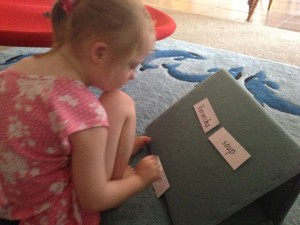
The next step in the reading program that I was pretty much making up as we went to suit where Veronika was at, was to make her 1st home reader. Being in her 1st year of full-time school, Veronika’s peers were going to be taking ‘home readers’ home….and we didn’t want Veronika to be any different……but how do you teach a basically non verbal child to read? Most of the early readers that I have seen have sentences like “this is my____”, and I wasnt sure how to teach Veronika words like this, is, and, the(etc) so I thought if she could have a book full of her things, then she WOULD be able to read it. Veronika can sign her name(she signs a V on her left forearm for her name) and could then sign the second word in the book. My goal for Veronika by the end of the year is to read 3 word sentences.
We also made up a sheet that Veronika can bring home in a letters and sounds folder(so it looks the same as the ones her peers have) and she has 4 words that we practice until she is ready for her teacher to test her on them. Veronika has a real love of learning, and a love of reading…..but as a Mum I still wanted Veronika to have a ‘voice’. One of my long-term goals for Veronika is to be understood in her community. For the most part I know what she is trying to ‘tell’ me, whether it’s a combination of her using her signs or visual cues, or just a process of elimination, but there are still times(often multiple times a day) when the frustration levels rise, Veronika’s and mine, because I just don’t understand what she is trying to tell me.
It was suggested to me, that maybe we look into a different AAC(Augmentative and Alternative Communication) device, one that might be more compatible with learning to read and continuing to expand Veronika’s vocabulary. So I had a chat to Veronika’s speech pathologist and she was happy for us to explore some other options. As we were talking I was saying to her speechy that if I could see into the future and someone could tell me when Veronika will talk verbally, if it wasnt going to be far away I wouldn’t look at another device, but unfortunately we can’t predict ‘when’ Veronika will talk, and her speech to be understood in the community, so we need to give her the best chance to develop her speech in the mean time.
We made an appointment with our local access communication speech pathologist, and he came up with 2 options and thought one might just suit Veronika more. So he arranged for us to borrow an Accent 1000 for a month, which we picked up almost 2 weeks ago. http://www.liberator.co.uk/accent-1000.html
It has been a pretty steep learning curve to get my head around a different AAC device, but with the help of the access communication speech pathologist, and Veronika’s private speechy Veronika had been putting some really nice 2 and 3 word combinations together, eg when drawing and wanting a colour ‘need colour pink'(or which colour she would like). Veronika and her speechy had a really lovely ‘learning game’ going on last week at her appointment, where she was asking for the colour of the things she wanted to roll down the tube.
and she was pretty impressed with herself as you can see from the photo below!
but this afternoon Veronika blew me away…..I was in the kitchen when Veronika tottered her way over to me and looked at me. I asked her to tell me what she wanted, as i held the ‘talker device’ in front of her
‘want eat cookie please’
Amazing, a beautiful 4 word sentence with manners! There was a descent amount of clapping, cheering and high 5-ing and then I gave Miss Veronika her cookie…..
Here is a link to some information about Minspeak and unity which Veronika is uning on the accent 1000

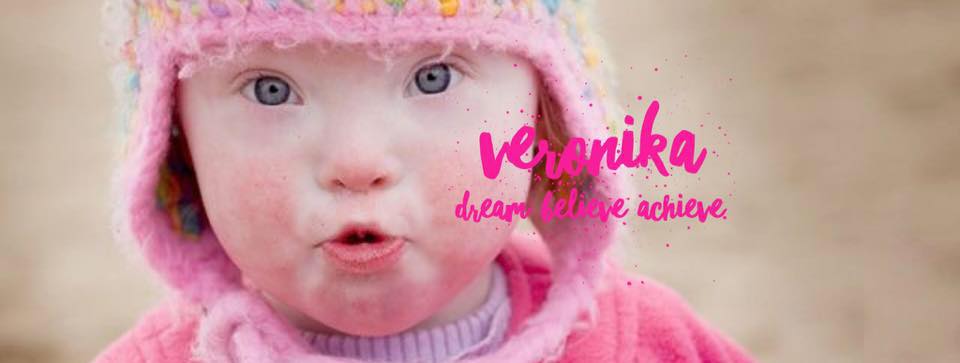
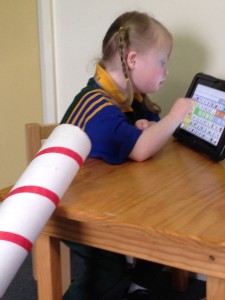
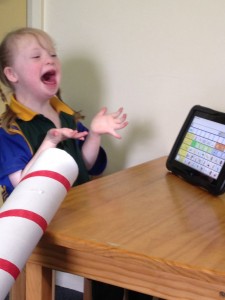
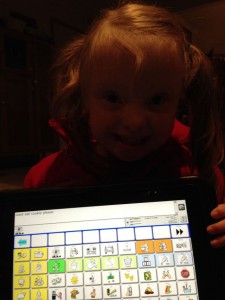
Leave a Reply